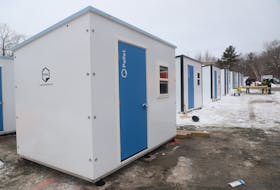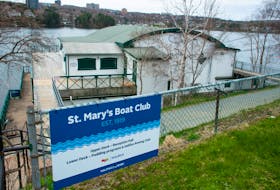LOWER TRURO, N.S. — Looking across the water at the old section of concrete, one could be forgiven for failing to appreciate its importance during a previous time.
“It’s always an interesting conversation when people say: ‘Oh, there was a bridge there?’” said Crawford Macpherson, Community Development director for the Municipality of Colchester County.
His response is usually to the effect that not only did the aging concrete abutment once serve as part of a bridge, it actually also used to make up a component of the Trans-Canada Highway.
“And, so that’s kind of an interesting historical, fun fact, if you like,” Macpherson said.
These days, when Macpherson looks across the water from the popular viewing spot of the tidal bore, he is more likely to be envisioning the creation of a pedestrian crossing, as opposed to the three-section steel-truss bridge that once spanned Salmon River, near where it spilled into Cobequid Bay.
“Anybody that we’ve talked with about the possibility of a pedestrian/cycling bridge gets pretty excited about that.
From a tourism perspective, he said, the site would be very easy to access by visitors who like to cycle.
“And something like that bridge over the river would be kind of iconic, it would be an attraction that everybody could see from the highway,” Macpherson said. “Probably the best viewing platform we could have. That gets everybody’s imagination going. And the neat thing would be to tie in the whole Nova Scotia Blue (cycling) Route, having that come through, having the old Palliser site as sort of the local gateway or hub for that trail and tying into the Cobequid Trail and back into Truro and down to Old Barns.”
The municipality, which owns the former Palliser restaurant and motel property, is in the process of developing a waterfront-viewing site for visitors to watch the tidal bore. Part of those plans entail creating a link to nearby Cobequid Trail and, if feasible, the construction of a pedestrian walkway across the water at the site of the old bridge.
And, given there are those who argue the sometimes sluggish tidal 'bore' might live up to its name, a pedestrian bridge could offer a unique and superior viewing perspective, while serving as a drawing card to attract more people to the site, Macpherson said.
In recent years, the Department of Transportation and Infrastructure Renewal has paved the road shoulders from Masstown Market to Debert and Macpherson anticipates the remaining seven kms to Mingo’s Corner will also be done. That would take the sidewalk right up to the Tidal Bore Road leading to where the Board Landing Bridge was located at the edge of the Cobequid Bay. And that would be an added factor that would make the area more attractive for cyclists and pedestrians alike, Macpherson said.
“So, from our standpoint there’s an outside (partner) that is interested,” he said. “Hopefully that interest brings some funding to it.”
Crawford said council has approved funding of up to $100,000 to begin the process of creating a design for a pedestrian bridge. "Once we get the design done, we’ll figure out what the costs are, then we’ll start looking for funding.”
-
1954 collapse of Board Landing Bridge
Looking at the old black and white photo of the badly mangled pickup truck sitting on the remains of the collapsed bridge below, one has to wonder how anyone could survive.
“Four Persons Only Slightly Hurt When Board Landing Bridge Span Collapses,” read the headline in the Aug. 10, 1954 edition of the Truro Daily News.
“Four Truro people, one of them an eight-months-old baby, had a miraculous escape from death or serious injury at about 8:30 last evening, when the Board Landing Bridge, two miles from Truro on the Amherst highway, collapsed, carrying the truck in which they were riding into the river bed some 20-ft. below,” the ensuing story read.
The article went on to say the incident occurred when the blade of a bulldozer being transported on the bed of a tractor-trailer connected with the side structures of the bridge, causing one of its three-spans to collapse. Although the tractor trailer and its cargo made it safely off the bridge, the pickup truck, travelling in the opposite direction, did not.
“Some moments elapsed then the entire bridge span gave way dropping into the river and carrying the small truck with it,” the article continued.
“When the bridge collapsed with the truck on it, the steel sides of the structure folded in, crushing down on the top of the truck, which is almost a total wreck. How the four occupants escaped death is nothing short of a miracle.”
The total length of the bridge was about 200 ft.
Hospital authorities at the time said none of the four were seriously injured, although all suffered from “minor bruises and shock.”
Then, as with now, the accident was quick to draw a crowd.
“As soon as news of the accident reached Truro, hundreds of sightseers drove to the scene, creating a bad traffic jam, until the situation was relieved by RCMP officers,” the article said.
Although there were no eye-witnesses to the accident, a guest in one of the motel cabins of the day described the sound of the bridge collapsing as being “like gravel flowing down a metal chute.”
-
How the Board Landing bridge got its name
When British Loyalists settled in the Truro area during the 1700s, one of their early types of industry took shape in the form of shipbuilding, alongside the Salmon River.
Information contained in the Nova Scotia Archives indicates the area in Lower Truro that now serves as a viewing spot for the tidal bore was once home to the type of shipbuilding activity that was occurring in other parts of Nova Scotia throughout the late 1700s and early 1800s, because of the naval industry of the day.
The first ship built in the Cobequid Bay area is said to have been constructed at that site, which was nicknamed the Board Landing.
“The board landing had been used for the transport of goods, services shipbuilding and travel, but it was mostly a place for lumber products to enter or leave Truro over the years,” archival information says. “The ship building period was when the board landing experienced its busiest time.”








